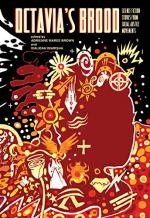|
This section contains 745 words (approx. 2 pages at 400 words per page) |

|
Octavia's Brood Summary & Study Guide Description
Octavia's Brood Summary & Study Guide includes comprehensive information and analysis to help you understand the book. This study guide contains the following sections:
This detailed literature summary also contains Quotes and a Free Quiz on Octavia's Brood by .
The following version of this book was used to create the guide: Imarisha, Walidah and brown, adrienne maree. Octavia's Brood: Science Fiction Stories from Social Justice Movements. AK Press, 2015.
Octavia's Brood is a collection of 21 short stories written by 21 different authors. The editors, Walidah Imarisha and adrienne maree brown commissioned this eclectic group of authors to write science fictional stories in the spirit of Octavia Butler's writings. The stories collected in the text are written from a range of different points of view. They each possess their own style, narrative atmosphere, and plot structure. The following summary employs a linear mode of explanation and relies upon the present tense.
In Bao Phi's "Revolution Shuffle," two unnamed main characters decide to stage a revolution. After the United States government interns black and brown citizens in labor camps, the main characters break into the camps to free their fellow citizens.
In David F. Walker's "The Token Superhero," Alonzo is born with superpowers. He becomes disillusioned with his work by the time he turns 20. When he realizes that black teenagers have been empowered by his heroic efforts, he realizes the importance of his role.
In adrienne maree brown's "the river," an unnamed woman realizes that the river near her home city is haunted. When the river starts disappearing white bodies, she understands that it is avenging black and brown people's violent deaths.
In Alexis Pauline Gumbs's "Evidence," Alexis and Alandrix communicate with one another throughout various eras in time. Their writings encourage one another not to give up hope.
In Walidah Imarisha's "Black Angel," fallen angel, A., realizes her ability to create change after she is dismissed from Earth. She decides to intervene in human affairs in order to save innocent lives.
In Morrigan Phillips's "The Long Memory," the main character, Cy, is a memory keeper. When she realizes her government wants to destroy people like her, she stages a hunger strike.
In Autumn Brown's "Small and Bright," Orion's people have lived underground for generations. Their cavernous communities have been a refuge from the violence above ground. When their people start dying out, Orion must leave the caverns in search of help.
In Alixa Garcia's "In Spite of Darkness," Ó uses oral storytelling traditions in order to teach her young daughter about the past.
In Mia Mingus's "Hollow," West and her companions have been deemed Unperfects by the ruling Perfects class. When they learn that the Perfects will destroy their home in Southing, they decide to leave and recreate their community elsewhere.
In Gabriel Teodros's "Lalibela," Lalibela is born with impressive capabilities. After a near-death experience, he understands his true calling.
In Tunde Olaniran's "Little Brown Mouse," Thomas is visited by a woman from the future who tells him he must stay alive to save people from dying in the future.
In Dawolu Jabari Anderson's "Sanford and Sun," Fred has a dream that Sun Ra visits him. During their meeting, Sun Ra encourages Fred to reclaim his identity.
In Tara Betts's "Runway Blackout," a unique class of shape-shifting supermodels decides to stage a resistance by appearing in Fashion Week only in their true black forms.
In Vagabond's "Kafka's Last Laugh," during her imprisonment, the main character, Resister, learns the importance of laughter to a successful revolution.
In Jelani Wilson "22XX: One-Shot," when Sasha learns that the government is weaponizing his school project, he decides to flee his home on Phobos in search of a better planet.
In Kalamu ya Salaam's "Manhunters," Mauve must face the truth of her past in order to overcome challenges in her present and future.
In LeVar Burton's "Aftermath," after Leon hears that Dr. Rene Reynolds has been kidnapped, he journeys into the unknown to save her.
In Terry Bisson's "Fire on the Mountain," Yasmin returns home to her mother-in-law and daughter after a long period away. Throughout her visit, she realizes she must heal these relationships in order to make a better future for her family.
In Dani McClain's "Homing Instinct," after the government issues a mandate requiring residents of coastal cities to relocate inland, the unnamed first person narrator struggles with the idea of leaving his hometown.
In Leah Lakshmi Piepzna-Samarasinha's "children who fly," Kumari's mother's death makes her realize that she must overcome her trauma and use her gift to help others.
In Mumia Abu-Jamal's "Star Wars and the American Imagination," the unnamed first person narrator considers the relationship between Star Wars and America's historic and future identities.
Read more from the Study Guide
|
This section contains 745 words (approx. 2 pages at 400 words per page) |

|



